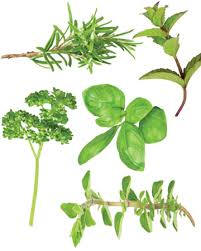Some everyday herbs to prepare and
use...
 The
subject of herbal medicine, particularly that used for animals, is a very complex one. There
are no veterinary surgeons in the UK who use herbal medicines exclusively, although many
homeopathic veterinary surgeons also use herbal treatments. The following general information
supplied by Mary Boughton of Dorwest Herbs may be helpful to you in treating your dogs
naturally. The
subject of herbal medicine, particularly that used for animals, is a very complex one. There
are no veterinary surgeons in the UK who use herbal medicines exclusively, although many
homeopathic veterinary surgeons also use herbal treatments. The following general information
supplied by Mary Boughton of Dorwest Herbs may be helpful to you in treating your dogs
naturally.
Nowadays there are a growing number of the more orthodox
veterinary practitioners using herbal medicines in conjunction with other treatments. This
seems the most acceptable and sensible way for herbal medicine to be used - as another form of
treatment to be used when appropriate for the condition presented.
Veterinary herbal medicines are licensed in the UK by the
VMD (Veterinary Medicines Directorate) which is a government agency associated with MAFF. There
are only 26 herbal veterinary medicines which are licensed in the UK, the remainder of 'herbal'
products being sold as food supplements and not to treat medical conditions.
There are many sources of herbs which are suitable for
preparation in the home - many of the fresh or dried culinary herbs available in shops can be
used in other ways and there are also suppliers of quality dried herbs. The cheapest and
simplest way, however, is to pick the plants fresh from your garden or the wild.
As so many of us now live in an increasingly polluted
environment, the most important thing to remember when proposing to pick herbs for use for
ourselves or our animals is the one of quality and purity. If you are lucky enough to live in a
rural area you can often pick plants from the wild, but remember it is illegal to uproot wild
plants so pick only the leaves, stems or berries that you require and leave the plant to grow
again next year.
Of
course, it is essential that you are able to identify the plant that you are going to pick, and
unless you are very familiar with the species it is best to refer to an standard book on wild
plants or herbs. A good herbal or botanical book will usually give you the information you need
to positively identify the plant but remember the golden rule is that if you are in doubt -
don't use it! As the common wild and culinary herbs are the easiest to find and require little
botanical knowledge, it is with this group that we shall start and you may be surprised at the
properties that some of these herbs have.
As carnivores are designed to cope with meat rather than
the chlorophyll in plants, they can only make full use of leafy herbs if they are chopped very
finely. It is this lack of ability to digest plants in their raw form which is the reason that
carnivores will often obtain partly digested plant material by eating cow and horse dung and
wild dogs and large cats will be seen eating the stomach of their prey with great relish! It
may not be so appealing to us but this does explain the sometimes strange preferences that our
domesticated animals still have for these tasty items. So make sure that you chop all herbs
very finely before adding it to the feed.
 Parsley Parsley
Parsley is perhaps the most widely used herb but it has many uses apart from cooking. contains
large amounts of vitamins and minerals and is mildly diuretic, so adding it to your dog or
cat's diet will help to provide a good source of Vitamin C as well as aiding the digestion.
It's mild diuretic action makes Parsley an excellent herb to cleanse the system and cool the
blood. There are 37 varieties of the curly leaved Parsley but the compact Triple Moss Curled
Parsley is reputed to have the highest medicinal value. Combined with other herbs Parsley is
used in many medicines to relieve rheumatic and arthritic pain, so it really is a most valuable
plant and has the advantage of being easy to obtain.
Watercress
Watercress is another well known and easily obtained plant which has a host of beneficial
uses. Most people know that it is rich in iron but did you know that it also contains Vitamins
A, C, B1 and B2 and because of its effects on the kidneys and bladder it is an ingredient of
medicines used to treat infections in these organs. Another very common herb is Celery,
although most of us will think of this as a vegetable rather than a herb. Its seeds are widely
used in medicines for the relief of arthritis and rheumatism because of its ability to relieve
both bone and muscle spasms, but the celery stems also have similar properties and again these
can be finely chopped to a pulp and added to the diet. The common Stinging Nettle might not be
so easy to pick, although with the aid of thick gloves it is relatively simple, but it is
certainly a plant that is worthwhile making the effort to collect. It has a high potassium and
calcium content and is a rich source of chlorophyll. This alone makes it an ideal addition to
the diet but as it is also used in medicines for rheumatism and arthritis as well as being
useful for sprains and joints we should perhaps all look at our nettle patch with more
affection in the future.
 Dandelion Dandelion
Dandelion leaves and root are widely used in herbal medicines; the root is perhaps too
difficult to deal with oneself but the leaves of Dandelion provide valuable nutritional
elements containing Vitamins A, B, C and D as well as iron and potassium. It is a tonic for the
liver and kidneys, stimulates the appetite, aids digestion and relieves flatulence and bloat. A
valuable herb indeed and one which most of us will have readily available and perhaps be
pleased to find a good use for!
So there we have Parsley, Nettle, Celery, Watercress and
Dandelion - all of which can be finely chopped and added to the daily feed. To provide a
variety of nutrients it is advisable to choose just two or three of these at a time and change
the mix regularly, perhaps depending on the needs of the animal, what you have available and
the season of the year. Next time we'll look at some of the cultivated herbs in the garden and
how they too can be prepared and used.
Most of the herbs mentioned here will be growing in your
garden and as you probably will have either grown them from seed or a plant from a reputable
nursery, identification should be simple, but before using any of them always ensure you know
the true identity of the plant.
Sage
Sage leaves have strong antiseptic properties but also a rather strong although pleasant
smell. One of its principal uses is as a mouthwash and for the quick relief of sore throats
although this may be more appropriate for the owner than the dog after a day on a dusty
showground ! Make an infusion of 1oz of dried or 2oz fresh Sage leaves using 1 pint boiling
water and allow to cool. Sipped slowly this will soothe sore throats immediately and cleanse
the mouth and gums. This infusion can also be rubbed on the gums and teeth of dogs or cats
suffering with gingivitis with good effect.
Peppermint
Peppermint is medicinally the most used member of the mint family and is well known as an aid
to digestion and this is just as appropriate for dogs as it is for people. An infusion of the
herb will aid digestion and a few leaves chopped finely and added to the feed will help to
prevent wind. It is also very soothing and warming making it beneficial for abdominal cramps as
well as sickness and vomiting.
 Garlic Garlic
Garlic is known as the 'king of herbs' because of its enormous value in medicine. It is
antibacterial, antiviral and antiseptic as well as having a specific beneficial effect on the
circulation and respiratory system. It is an internal purifier of great importance having the
ability to cleanse the system, stimulate the immune system and treat infections.
Although its use internally is of greatest value, the
juice and oil can be used externally to aid healing of wounds and its strong smell acts as a
flea repellent. The cloves of garlic can be crushed and added to the food but it really is one
of the herbs which is best given in tablet form, mainly so that sufficient quantities can be
administered but also to avoid the smell which some people find unpleasant. To increase
resistance to fleas and worms, to treat and prevent infections and increase general health
there is nothing to approach the effect of this wonderful herb.
Rosemary
Finally, Rosemary must be mentioned as a valuable herb from the garden which can be used
for more than just cooking - it is the oil of Rosemary that gives its characteristic odour and
it is this volatile oil in the leaves which contain the valuable properties of the herb. It is
used internally to aid digestion and strengthen the heart but can also be used externally to
rub on the coat to improve condition and prevent scurfiness as well as having the added benefit
of flea repellent properties.
It has much too woody a leaf to be able to chop finely
enough to add to the feed but can be given in its powdered form, or pulped in a blender. For
external use it is best used from an infusion made with 1oz dried herb to 1 pint boiling water
and allowed to cool.
 About the author... About the author...
Mary Boughton owns and manages Dorwest Herbs. Her
background and upbringing was concerned with the actual herbs themselves - their
identification, properties and therapeutic uses. Her expertise nowadays is concentrated on the
quality controls applied to herbal medicines and the technical side of their production. She
lectures on the subject to vets and students around the world and has become the UK's
specialist on the standards applied to the production of veterinary herbal medicines. She is a
Member of NOAH’s Companion Animal Sub-group and the British Herbal Medicine Association's
Veterinary Committee.
For more information, visit
http://www.dorwest.co.uk
|